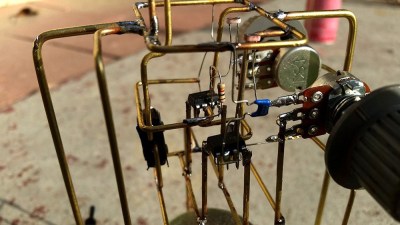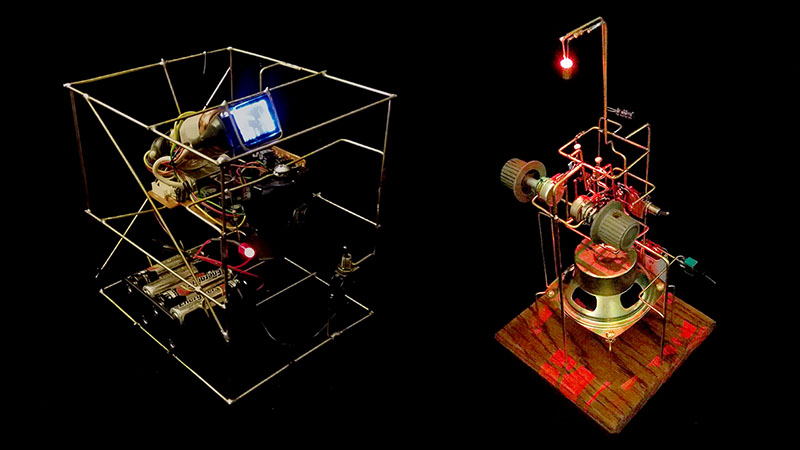This stunning piece of art is [Emily Velasco’s] take on the Atari Punk Console. It’s a freeform circuit that synthesizes sound using 555 timers. The circuit has been around for a long time, but her fabrication is completely new and simply incredible!
This isn’t [Emily’s] first rodeo. She previously built the mini CRT sculpture project seen to the left in the image above. Its centerpiece is a tiny CRT from an old video camera viewfinder, and it is fairly common for the driver circuit to understand composite video. And unlike CRTs, small video cameras with composite video output are easily available today for not much money. Together they bring a piece of 1980s-era video equipment into the modern selfie age. The cubic frame holding everything together is also the ground plane, but its main purpose is to give us an unimpeded view. We can admire the detail on this CRT and its accompanying circuitry representing 1982 state of the art in miniaturized consumer electronics. (And yes, high voltage components are safely insulated. Just don’t poke your finger under anything.)
 With the experience gained from building that electrically simple brass frame, [Emily] then stepped up the difficulty for her follow-up project. It started with a sound synthesizer circuit built around a pair of 555 timers, popularized in the 1980s and nicknamed the Atari Punk Console. Since APC is a popular circuit found in several other Hackaday-featured projects, [Emily] decided she needed to add something else to stand out. Thus in addition to building her circuit in three-dimensional brass, two photocells were incorporated to give it rudimentary vision into its environment. Stimulus for this now light-sensitive APC were provided in the form of a RGB LED. One with a self-contained circuit to cycle through various colors and blinking patterns.
With the experience gained from building that electrically simple brass frame, [Emily] then stepped up the difficulty for her follow-up project. It started with a sound synthesizer circuit built around a pair of 555 timers, popularized in the 1980s and nicknamed the Atari Punk Console. Since APC is a popular circuit found in several other Hackaday-featured projects, [Emily] decided she needed to add something else to stand out. Thus in addition to building her circuit in three-dimensional brass, two photocells were incorporated to give it rudimentary vision into its environment. Stimulus for this now light-sensitive APC were provided in the form of a RGB LED. One with a self-contained circuit to cycle through various colors and blinking patterns.
These two projects neatly bookend the range of roles brass rods can take in your own creations. From a simple frame that stays out of the way to being the central nervous system. While our Circuit Sculpture Contest judges may put emphasis the latter, both are equally valid ways to present something that is aesthetic in addition to being functional. Brass, copper, and wood are a refreshing change of pace from our standard materials of 3D-printed plastic and FR4 PCB. Go forth and explore what you can do!















At least to me these projects always feel like someone tried to forcibly combine technology with aesthetics without knowing much about either. Yeah, the sculpures look “strange”, but the design doesn’t improve the electronics and vice versa. The mini CRT sculpture is literally just a gutted, unmodified mini CRT in a brass frame. It might be interesting to some because you can see what is normally hidden, and you can construct some philosophical stuff around that, but the case of an iMac 3G was transparent as well and nobody considers it a piece of art with hidden meanings on multiple philosophical layers.
To me artists are masters of their trade, but every time I see one of these art/technology installations or sculptures I can’t help but think that the artist doesn’t know much about technology and that every member of a hackerspace or half the steampunk community could have done better. I’ve seen lots of these installations and sculptures which were even created by other people because the artist couldn’t have done it themselves.
The guy from Wibtergatan building that marble machine – that’s an artist.
I agree with you on the CRT – it’s a couple boards and a battery pack suspended in a frame. But the Atari punk console does a much better job.
>…but the case of an iMac 3G was transparent as well and nobody considers it a piece of art with hidden meanings on multiple philosophical layers.
It’s an Apple product and both Steve Jobs and Jony Ive have been attributed with the design. So clearly you’re wrong.
Sounds a lot like when people claim a child could have done a work of abstract art. If you think you can make something better maybe you should. Worst case is there’s more art in the world.
I think that’s the best case actually. The worst case is that it turns out that the sculpture exactly resembles a dark summoning sigil and sucks the city into a half world-half hell landscape.
+1
Wait which post was this? Sounds like a perfect project to start on next
Depending on the city you might not notice the difference or would possibly be an improvement.
No, it doesn’t. Claiming that a kid could do it means that absolutely no skills are required, devalueing the work completely. My point is that skilled craftspeople could have done and have done this better. So while I see some value in the work and definitely not everybody could have done this, it is still pretty basic compared to other works in the field and doesn’t show a lot of imagination or even a clever combination of technology and aesthetics. In my eyes it doesn’t cross the barrier for what I consider art.
I’ve been to plenty of art installations which tried to make something cool using advanced technologies and my observation is that there are very, very, very few artists which have mastered these technology like e.g. old painters have mastered the art of using their brushes. Most artists getting paid for these sculptures and installations cannot use a soldering iron and would not be able to write a line of code, while the entertainment industry gives us new and incredible things every day.
This is some ridiculous gatekeeping. Both of these are awesome builds and I love them. If they’re not hardcore enough for you, let’s see your creations to top these.
Emily, this is beautiful work all around, from conception to form and function. Kudos!
1. The creator didn’t use the labels “art” or “artist” for the work or themselves as far as I can see, this post did. So it’s not even about what the creator saw in it or wanted it to be, but generally about the point when craftsmanship becomes art and my discontent with what museums and galleries consider to be art when technology is involved.
2. I never said it wasn’t beautiful or well made. I even specifically said that not everybody could do this, but art is more than something being beautiful and well made – at least to me.
3. I emphasized multiple times that this was my subjective perception. I’m just a stupid nickname on the Internet. Never let yourself get discouraged by a stupid nickname on the Internet, especially when you’re not even trying to be treated as an artist. Best to never read the comments at all.
4. Ad Hominem.
Speaking as a high school and fine arts school drop out (engineering was my failsafe, but only after aging out of bike racing) I’m a pain in the butt snob about everything. So! I can relate to your critique and find most electronic art to be more “craft” or “science project.” With that written, I’d enjoy seeing Emily’s work in person because I’m sure at some level I’d find it provocative, maybe as an engineer, maybe as a failed artist or maybe as a regular Joe looking at something cool. . . and that is art enough for me.
“Modern art has to be what is called ‘intense.’ it is not easy to define being intense; but, roughly speaking, it means saying only one thing at a time, and saying it wrong.”
― G.K. Chesterton, Alarms and Discursions
Reminds me of Peter Vogel, i will make something like this someday.
https://vimeo.com/59829961
Love the Freeform RGB Atari punk console video. Nice job.
This is a straight-up badass project that clearly required skill, talent, and persistence to create, and it’s laughable that anyone would take time out of their day to say something negative about it.
Awesome build, Emily!
+1
This freeform Atari Punk Console is awesome. Emily takes a fun, well-known circuit and makes it more usable, more interactive, more visceral, more tactile. Playing with it looks like one is futzing with a weird alien gizmo from a B-movie sci-fi set. But the technical execution is better than most sci-fi props! This is a fun piece of beautiful functional art. If it’s not for you, fine. But it’s still art.
Thinking about the older project containing “just” a CMOS camera hooked up to a CRT got me to thinking about how it might be neat to have a have a picture tube and camera tube both driven using the same deflection circuitry … and then having the deflection rates be something else instead instead of the normal sawtooth. Maybe lissajous figures or some chaotic attractor.
I like both the builds. It’s cool using the solid brass frame as wiring. It reminds me of how some 1920s radios were wired up, with solid brass bars as the conductors. As for the CRT tube…add a magnifying glass in front of it and it’ll look like something from the movie “Brazil”. :)